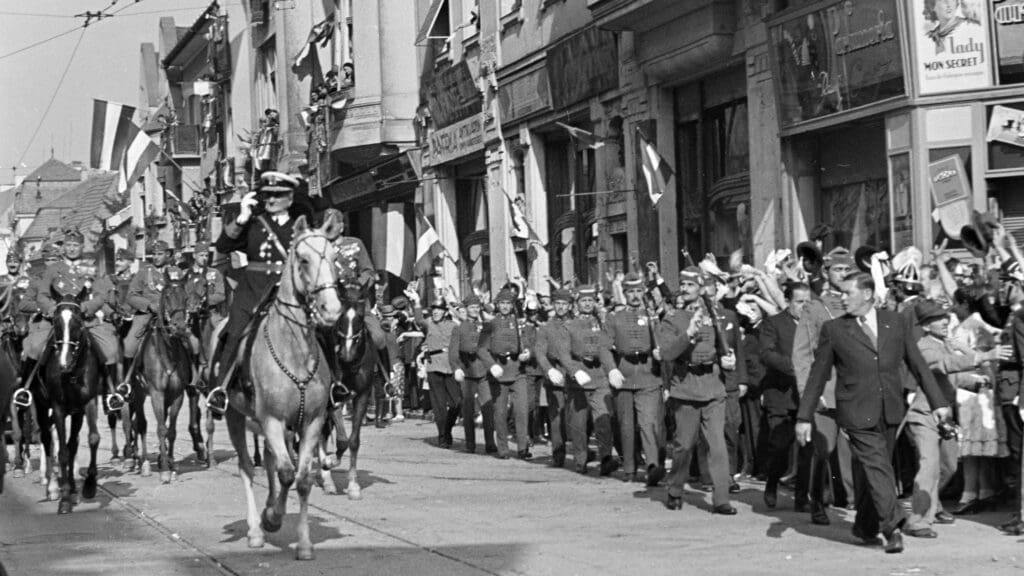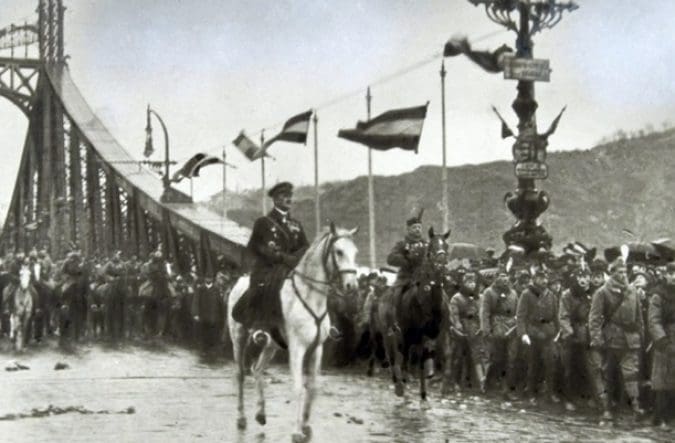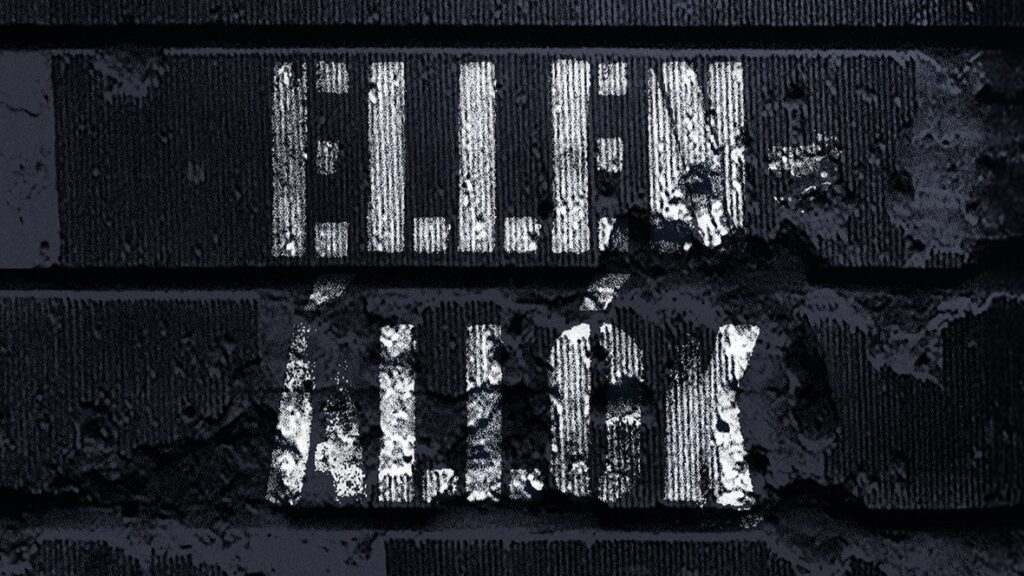On 16 November 1919, Miklós Horthy, the future Regent of Hungary, marched on Budapest, taking power, and ending the chaotic period of the previous two years. But it was a long series of events that led to this remarkable day in history.
Republic and Soviet Republic
The period of 1918–1920 was a turbulent and tragic era of Hungarian history. During October and November of 1918, the First World War ended, leading to the collapse of the Austro–Hungarian Empire. Hungary became an independent republic, under the leadership of Mihály Károlyi. His weak and incompetent rule, however, did not help the already abysmal conditions of the country. Troops of members of the Small Entente, including Romania and Serbia, advanced toward Budapest, despite of the ceasefire that has been signed earlier. These forces did not only occupy the territories awarded to them later in Versailles, but also pushed forward way beyond them, and, in fact, even beyond the ceasefire line. The armed forces of Hungary started to disintegrate, while famine and poverty ravaged the chaotic country. Eventually, Károlyi was ousted in a technical coup by the Communists on 21 March 1919.
The Soviet Republic of Hungary, led by Béla Kun, lasted for 133 days. On one hand, it stabilized the rump state of Hungary, and led—often successful—counteroffensives against the Small Entente, while also initiating many social welfare programmes for the war-torn country. On the other hand, it bore all the characteristics of the contemporary Russian Bolshevik regime. Thus, the state functioned as a Communist military dictatorship. It nationalized private property, and, contrary to the contemporary leftist mantra, the Kun-regime did not even respect personal property, going as far as confiscating flats and even forcing people to let their bathrooms being turned into public spaces.
Any dissent was brutally suppressed via terror, including mass executions, political assassinations, and abductions of civilians.
The Soviet Republic became deeply unpopular, especially in the rural areas, where farmers took up arms against it, only to be suppressed and murdered en masse by the most infamous figure of the regime, Tibor Szamuely and his terror troops.
Partly due to the Bolshevik aim to fight the ‘bourgeois’ Entente, and partly due to the genuine patriotism of some individual regime figures, especially generals and soldiers, the Soviet Republic reorganized the army and took up the fight against the invaders. It held up Romanian forces successfully, while went into counter-offensive in (Czecho)Slovakia. The southern regions of Slovakia, mostly Hungarian-populated, regions were liberated by the efficient general, Aurél Stromfeld. However, during the summer of 1919, Romania overcame the Hungarian line of defence, while Slovakia was evacuated due to an international agreement. The military collapsed, and so did the little legitimacy that the Communists had. As the Romanian army approached Budapest, the Social Democrats broke with the Communists, and ousted their government on 2 August. Kun, Szamuely, and most of the other Bolshevik cadres fled, or tried to flee, to Vienna (even if Kun did in fact not fly out of the country on an airplane, stuffed with gold and stolen jewellery, as memorized by a novel of Dezső Kosztolányi).
Interlude
After the collapse of the Soviet Republic, a so called ‘trade union government’ was set up by the Social Democrats, led by Gyula Peidl. However, that administration did not last long either. On 6 August, István Friedrich, a right-wing political adventurer, who also helped Károlyi to topple the Habsburgs, united the anti-Communist forces and organized a bloodless, haphazard coup. Friedrich ambushed the cabinet meeting of the government with his comrades, forcing its resignation. Initially, the putschists were not taken seriously; Peidl allegedly asked Friedrich if he ‘imagined himself being in the middle of a fancy-dress party of a carnival’. However, in those chaotic days, this swift action was enough to change the form of government. Led by Friedrich, a right-wing administration took over. The Romanian troops, which had marched into Budapest during these days, accepted, and even encouraged this change.
The months between August and November were likewise chaotic and insecure.
In fact, it was not even clear what form of government Hungary had in that period. Some English language sources call this era the ‘Republic of Hungary’ (the rule of Károlyi being the ‘People’s/Democratic Republic’). However, after Friedrich took over, a Habsburg prince, Joseph August was named as the head of state, with a title implying that he held the position temporarily, in absence of the king. He appointed Friedrich as prime minister, legitimizing his power grab, only to be forced to resign by the Entente, which feared a Habsburg restoration. However, Friedrich was not exactly acceptable for the powers that held Hungary occupied. A desperate search started to find a suitable person, whom the victorious nations would accept as their legitimate partner in negotiations. Finally, a former Austro-Hungarian rear admiral was chosen, who was known for his pro-British views and British connections: Miklós Horthy.
Horthy’s Triumphant March
Horthy as a choice was not out of the blue, since he had already become an active organizer of the counterrevolutionary forces during the spring of 1919. After personally overseeing the handover of the surrendering Austro-Hungarian navy to the Entente in 1918, he resigned his post, ending his decades-long military career in the Monarchy.
During the Károlyi period, Horthy lived at his rural estate. However, after the Communist took over, he fled to Szeged, therefore to the French occupation area, and started to organize a counter-revolutionary force, the Hungarian National Army. He also became the minister of defence in the Szeged-based counter-government of Gyula Károlyi, and started to recruit volunteers for the National Army, with the aim of fighting the Communists. While no such battle took place, on 18 August, Horthy, with the authorization of the Entente, marched to the Transdanubia region of Hungary and saw to restoring order. His troops captured towns almost always without a single gunshot fired. This led to the complete obliteration of the Soviet Republic’s authorities on the local level, and prevented an interregnum, or, even worse, foreign occupation, in the remaining free areas of Hungary.
However, this era had a darker side, too. Some smaller units of the army (the so called ‘officers’ platoons’), often without the authorization of Horthy, started to hunt down and execute those who had a role in the Communist regime, or were perceived to have done so. The reprisals were brutal, and often targeted mere foot soldiers, or simply Jewish civilians, seen by the extreme right as collectively responsible for Bolshevism.
While Horthy cooperated with Friedrich, he did not recognize him as his superior. Therefore,
as soon as the Entente accepted Horthy as the de facto ruler of Hungary, he marched on Budapest.
His army’s strength was also much greater than that of Friedrich’s. On 16 November 1919, he entered the capital again without any gunshots fired. Thus he became the effective ruler of the country, while still only holding the title of ‘Supreme Leader’.
The paraphernalia of the march were theatrical. Horthy mounted a white stallion at the Kelenföld train station, where he had arrived by train from Siófok, his Transdanubia headquarters. From here, he proceeded on horseback to Gellért Square. Riding a white stallion became his ‘trademark’, a powerful symbol associated with his persona. Horthy also used this theatrical element during the 1938–1940 period, when he marched into the cities re-annexed to Hungary after the Vienna Awards. Entering the rewon territories on horseback symbolized ‘retaking Hungary’, since Prince Árpád, who had conquered the Carpathian Basin for Hungarians in 895, allegedly also rode a white horse. These episodes, however, since the Treaty of Trianon disbanded the navy of Hungary, also earned Horthy the sarcastic nickname ‘Admiral-on-Horseback’.

At Gellért Square, Horthy was received enthusiastically by the people of the city, and an emissary of the municipal government also greeted him. It was there that Horthy held his famous (or infamous, some would say) speech about a ‘guilty Budapest’. In this speech, he blamed the people of city for accepting, or even supporting the Communist regime. However, he also made it clear that he ‘forgives’ any collaborator who is ready to change their mind and heart and accept the rule of a ‘patriotic government’.
Conclusion
After his speech, Horthy and his troops marched onward, toward the Parliament, marking the end of their symbolic ‘conquest’.
Despite these events, the administration of Friedrich stayed in office until 24 November. On that day, and by Entente initiative, a government of national unity was appointed, under Károly Huszár, which even included the Social Democrats. This government worked toward settling a formal peace treaty with the Entente, even if Horthy, as the ‘Supreme Leader’ and head of the army, had undisputed final say on all matters.
During the next year, a Constituent National Assembly was elected and started its work as the legislature of Hungary. In March, it elected Horty Hungary’s Regent, the head of state of Hungary, making him now not only de facto, but also the legal, de jure leader of the country.
Via this act, the monarchy was restored, with Horthy as ‘provisional’ ruler.
That was then the 20-year-long period, now commonly called the ‘Horthy era’, commenced. But one of the most debated periods of Hungarian history was in fact born on 16 November 1919.
Related articles:








